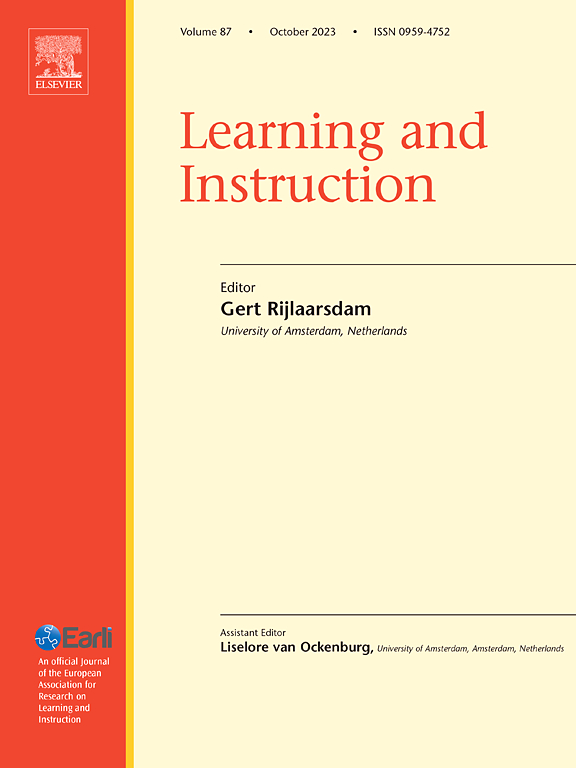The dynamics of creative agency: Insights from two intensive diary studies on university students
IF 4.9
1区 教育学
Q1 EDUCATION & EDUCATIONAL RESEARCH
引用次数: 0
Abstract
Background
Creative processes and actions are driven not only by people's abilities but also by their confidence and readiness to invest effort.
Aims
This intensive, daily-diary investigation (two studies, total Nparticipants = 362, Nmeasurements = 8322 over three and four weeks) explored how students’ self-perception (creative confidence) and self-regulation—two aspects of creative agency—shape the likelihood of undertaking creative action.
Samples
Study 1 included 234 university students (5923 student-day units); Study 2 included 128 university students (2399 student-day units).
Methods
In Study 1, participants completed daily diary measurements over four weeks, reporting on their creative self-perception and engagement in creative activities. Using dynamic structural equation modeling (DSEM), we analyzed cross-day lagged associations between creative activity and confidence. In Study 2, students completed daily diaries during a three-week creative project while receiving either self-regulation-enhancing prompts (experimental group) or no additional support (control group). Multilevel regression analyses estimated differences in students’ creative self-perception and creative engagement resulting from strengthened self-regulation.
Results
Study 1 showed a robust effect of the previous day's creative activity on the next day's confidence, and no effect of confidence on activity. In Study 2, students whose self-regulation was activated reported higher creative confidence and task-specific creative self-efficacy than the control group and engaged more in creative activities in everyday settings.
Conclusions
These findings shed light on the role of perceived agency for creative action and the dynamic interplay of self-beliefs and self-regulation. They also open avenues for developing brief interventions to make creativity more salient in students’ everyday in- and out-of-school settings.
创意代理的动态:来自两项针对大学生的密集日记研究的见解
创造性的过程和行动不仅取决于人们的能力,还取决于他们的信心和投入努力的意愿。目的:这项密集的、每日日记式的调查(两项研究,共n名参与者= 362,n测量值= 8322,为期三周和四周)探讨了学生的自我感知(创造性自信)和自我调节——创造性代理的两个方面——如何塑造从事创造性行动的可能性。研究1包括234名大学生(5923学日单位);研究2包括128名大学生(2399个学生日单位)。在研究1中,参与者完成了为期四周的每日日记测量,报告了他们的创造性自我感知和创造性活动的参与情况。使用动态结构方程模型(DSEM),我们分析了创造性活动和信心之间的跨日滞后关联。在研究2中,学生们在接受自我调节增强提示(实验组)或没有额外支持(对照组)的情况下,在为期三周的创意项目中完成每日日记。多水平回归分析估计了自我调节增强对学生创造性自我知觉和创造性投入的影响。结果研究1显示,前一天的创造性活动对第二天的信心有显著影响,而信心对活动没有影响。在研究2中,自我调节被激活的学生比对照组表现出更高的创造性自信和特定任务的创造性自我效能,并且在日常环境中参与更多的创造性活动。这些发现揭示了感知代理在创造性行为中的作用,以及自我信念和自我调节之间的动态相互作用。它们还为制定简短的干预措施开辟了道路,使创造力在学生的日常校内外环境中更加突出。
本文章由计算机程序翻译,如有差异,请以英文原文为准。
求助全文
约1分钟内获得全文
求助全文
来源期刊

Learning and Instruction
Multiple-
CiteScore
11.30
自引率
4.80%
发文量
109
期刊介绍:
As an international, multi-disciplinary, peer-refereed journal, Learning and Instruction provides a platform for the publication of the most advanced scientific research in the areas of learning, development, instruction and teaching. The journal welcomes original empirical investigations. The papers may represent a variety of theoretical perspectives and different methodological approaches. They may refer to any age level, from infants to adults and to a diversity of learning and instructional settings, from laboratory experiments to field studies. The major criteria in the review and the selection process concern the significance of the contribution to the area of learning and instruction, and the rigor of the study.
 求助内容:
求助内容: 应助结果提醒方式:
应助结果提醒方式:


